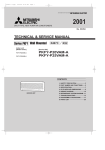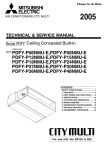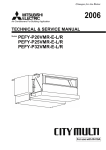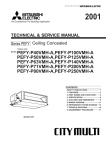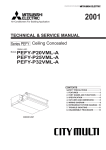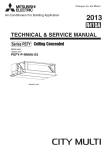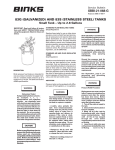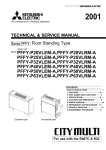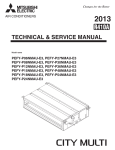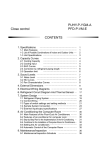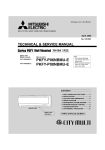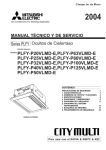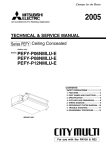Download Service Manual
Transcript
2013
MANUFACTURED FOR:
MITSUBISHI ELECTRIC US, INC.
TECHNICAL & SERVICE MANUAL
Series PVFY Vertical Concealed Indoor Unit “B”
<Indoor unit>
Models
PVFY-P12E00B, PVFY-P18E00B
PVFY-P24E00B, PVFY-P30E00B
PVFY-P36E00B, PVFY-P48E00B
PVFY-P54E00B
CONTENTS
SAFETY PRECAUTIONS ························· 1
1. FEATURES············································3
2. PART NAMES AND FUNCTIONS ········ 4
3. SPECIFICATION ··································· 7
4. OUTLINES AND DIMENSIONS············ 9
5. WIRING DIAGRAM ····························· 12
6. REFRIGERANT SYSTEM DIAGRAM···· 13
7. TROUBLESHOOTING ························ 14
For use with R410A only
Specifications are subject to change without notice.
© 2013 Mitsubishi Electric US, Inc.
SAFETY PRECAUTIONS
1.
Before installation and electric work
s Before installing the unit, make sure you read all the
“Safety precautions”.
s The “Safety precautions” provide very important
points regarding safety. Make sure you follow them.
s This equipment may not be applicable to EN61000-32: 1995 and EN61000-3-3: 1995.
s This equipment may have an adverse effect equipment on the same electrical supply system.
s Please report to or take consent by the supply authority before connection to the system.
Symbols used in the text
•
•
•
•
•
•
Warning:
Describes precautions that should be observed to prevent danger
of injury or death to the user.
Caution:
Describes precautions that should be observed to prevent damage
to the unit.
•
•
Symbols used in the illustrations
: Indicates an action that must be avoided.
: Indicates that important instructions must be followed.
: Indicates a part which must be grounded.
•
: Indicates that caution should be taken with rotating parts. (This
symbol is displayed on the main unit label.) <Color: Yellow>
: Beware of electric shock (This symbol is displayed on the main
unit label.) <Color: Yellow>
•
Warning:
Carefully read the labels affixed to the main unit.
•
•
•
•
•
•
Warning:
Ask the dealer or an authorized technician to install the air conditioner.
- Improper installation by the user may result in water leakage, electric shock, or fire.
Install the air unit at a place that can withstand its weight.
- Inadequate strength may cause the unit to fall down, resulting in
injuries.
Use the specified cables for wiring. Make the connections securely so that the outside force of the cable is not applied to the
terminals.
- Inadequate connection and fastening may generate heat and
cause a fire.
Prepare for typhoons and other strong winds and earthquakes
and install the unit at the specified place.
- Improper installation may cause the unit to topple and result in
injury.
Always use an air cleaner, humidifier, electric heater, and other
accessories specified by Mitsubishi Electric.
- Ask an authorized technician to install the accessories. Improper
installation by the user may result in water leakage, electric shock,
or fire.
2
•
Never repair the unit. If the air conditioner must be repaired,
consult the dealer.
- If the unit is repaired improperly, water leakage, electric shock, or
fire may result.
Do not touch the heat exchanger fins.
- Improper handling may result in injury.
When handling this product, always wear protective equipment.
EG : Gloves, full arm protection namely boiler suit, and safety glasses.
- Improper handling may result in injury.
If refrigerant gas leaks during installation work, ventilate the
room.
- If the refrigerant gas comes into contact with a flame, poisonous
gases will be released.
Install the air conditioner according to this Installation Manual.
- If the unit is installed improperly, water leakage, electric shock, or
fire may result.
Have all electric work done by a licensed electrician according
to “Electric Facility Engineering Standard” and “Interior Wire
Regulations”and the instructions given in this manual and always use a special circuit.
- If the power source capacity is inadequate or electric work is performed improperly, electric shock and fire may result.
Securely install the cover of control box and the panel.
- If the cover and panel are not installed properly, dust or water
may enter the outdoor unit and fire or electric shock may result.
When installing and moving the air conditioner to another site,
do not charge the it with a refrigerant different from the refrigerant (R410A) specified on the unit.
- If a different refrigerant or air is mixed with the original refrigerant,
the refrigerant cycle may malfunction and the unit may be damaged.
If the air conditioner is installed in a small room, measures
must be taken to prevent the refrigerant concentration from
exceeding the safety limit even if the refrigerant should leak.
- Consult the dealer regarding the appropriate measures to prevent the safety limit from being exceeded. Should the refrigerant
leak and cause the safety limit to be exceeded, hazards due to
lack of oxygen in the room could result.
When moving and reinstalling the air conditioner, consult the
dealer or an authorized technician.
- If the air conditioner is installed improperly, water leakage, electric shock, or fire may result.
After completing installation work, make sure that refrigerant
gas is not leaking.
- If the refrigerant gas leaks and is exposed to a fan heater, stove,
oven, or other heat source, it may generate noxious gases.
Do not reconstruct or change the settings of the protection
devices.
- If the pressure switch, thermal switch, or other protection device
is shorted and operated forcibly, or parts other than those specified
by Mitsubishi Electric are used, fire or explosion may result.
Specifications are subject to change without notice.
© 2013 Mitsubishi Electric US, Inc.
•
2.
Warning:
Note the following when building a heater in the air
conditioning system.
- Leave enough space between units for proper ventilation so that
the indoor unit temperature does not exceed 40°C when
windless.
- Keep the heater clean, and take appropriate measures so that
the indoor unit does not suck in the dust particles that
accumulate on the heater.
- Use the optional heater cable (PAC-YU25HT) to perform an
interlocked operation with indoor units.
- Do not build a heater inside the indoor unit.
Caution:
•
•
Recommended circuit
Wiring diagram
R
1-phase power
supply
88H
FS1
H1
88H
FS2
FS1
H2
S
208V, 230V/60Hz
R
S
FS2
88H
26H
•
•
Control board
CN24
•
FS1, 2 ----- Thermal fuse
H1, H2 ----- Heater
26H --------- Overheat protection
thermostat
•
88H --------- Electromagnetic contactor
•
•
•
•
3
Precautions for devices that use
R410A refrigerant
Do not use the existing refrigerant piping.
- The old refrigerant and refrigerator oil in the existing piping contains a large amount of chlorine which may cause the refrigerator
oil of the new unit to deteriorate.
Use refrigerant piping made of C1220 (Cu-DHP) phosphorus
deoxidized copper as specified in the *JIS H3300 “Copper and
copper alloy seamless pipes and tubes”. In addition, be sure
that the inner and outer surfaces of the pipes are clean and
free of hazardous sulphur, oxides, dust/dirt, shaving particles,
oils, moisture, or any other contaminant.
- Contaminants on the inside of the refrigerant piping may cause
the refrigerant residual oil to deteriorate.
*JIS: Japanese Industrial Standard
Store the piping to be used during installation indoors and keep
both ends of the piping sealed until just before brazing. (Store
elbows and other joints in a plastic bag.)
- If dust, dirt, or water enters the refrigerant cycle, deterioration of
the oil and compressor trouble may result.
Use ester oil, ether oil or alkylbenzene (small amount) as the
refrigerator oil to coat flares and flange connections.
- The refrigerator oil will degrade if it is mixed with a large amount of
mineral oil.
Use liquid refrigerant to fill the system.
- If gas refrigerant is used to seal the system, the composition of
the refrigerant in the cylinder will change and performance may
drop.
Do not use a refrigerant other than R410A.
- If another refrigerant (R22, etc.) is used, the chlorine in the refrigerant may cause the refrigerator oil to deteriorate.
Use a vacuum pump with a reverse flow check valve.
- The vacuum pump oil may flow back into the refrigerant cycle and
cause the refrigerator oil to deteriorate.
Do not use the following tools that are used with conventional
refrigerants.
(Gauge manifold, charge hose, gas leak detector, reverse flow
check valve, refrigerant charge base, vacuum gauge, refrigerant recovery equipment)
- If the conventional refrigerant and refrigerator oil are mixed in the
R410A , the refrigerant may deteriorated.
- If water is mixed in the R410A , the refrigerator oil may deteriorate.
- Since R410A does not contain any chlorine, gas leak detectors
for conventional refrigerants will not react to it.
Do not use a charging cylinder.
- Using a charging cylinder may cause the refrigerant to deteriorate.
Be especially careful when managing the tools.
- If dust, dirt, or water gets in the refrigerant cycle, the refrigerant
may deteriorate.
Specifications are subject to change without notice.
© 2013 Mitsubishi Electric US, Inc.
1
FEATURES
Series PVFY Vertical Concealed Indoor Unit “B”
Indoor unit
Models
3
4
Cooling capacity/Heating capacity
kW
Btu / h
PVFY-P12E00B
3.5 / 4.0
12,000 / 13,500
PVFY-P18E00B
5.3 / 5.9
18,000 / 20,000
PVFY-P24E00B
7.0 / 7.9
24,000 / 27,000
PVFY-P30E00B
8.8 / 10.0
30,000 / 34,000
PVFY-P36E00B
10.6 / 11.7
36,000 / 40,000
PVFY-P48E00B
14.1 / 15.8
48,000 / 54,000
PVFY-P54E00B
15.8 / 17.6
54,000 / 60,000
Specifications are subject to change without notice.
© 2013 Mitsubishi Electric US, Inc.
2
PART NAMES AND FUNCTIONS
l Indoor (Main) Unit
Horizontal Left
Vertical
[PAR-21MAAU]
l Remote controller
l Once the controls are set, the same operation mode can
be repeated by simply pressing the ON/OFF button.
l Operation buttons
1
TEMP.
2
3
MENU
BACK
PAR-21MAA
MONITOR/SET
ON/OFF
ON/OFF
FILTER
DAY
CHECK TEST
OPERATION
CLOCK
B
7
A
0
CLEAR
C
D
1
2
3
4
[Set Temperature] Button
[Timer Menu] Button
[Monitor/Set] Button
[Mode] Button
[Return] Button
[Timer On/Off] Button
[Set Day] Button
5
6
7
8
9
4
5
6 8
[Louver] Button
[Operation] Button
[Fan Speed] Button
[Airflow Up/Down] Button
[Ventilation] Button
[Operation] Button
[Check/Clear] Button
9
0 [Test run] Button
A [Filter] Button
[
] Button
B [ON/OFF] Button
C Position of built-in room temperature
D [Set Time] Button
• Never expose the remote controller to direct sunlight. Doing so can result in the erroneous measurement of room temperature.
• Never place any obstacle around the lower right-hand section of the remote controller. Doing so can
result in the erroneous measurement of room temperature.
5
Specifications are subject to change without notice.
© 2013 Mitsubishi Electric US, Inc.
[Display]
A
CENTRALLY CONTROLLED
E
B
ON
C
STAND BY
DEFROST
6
C
ERROR CODE
NOT AVAILABLE
TEMP.
G
A
B
C
D
E
F
G
H
I
J
K
L
M
N
O
P
1Hr.
OFF
CLOCK
CHECK
C
P
Current time/Timer
Centralized control
Timer OFF
Timer indicator
Operation mode: COOL, DRY,
“Locked” indicator
Set temperature
Power ON
Louver
Ventilation
Filter sign
Set effective for 1 hr.
Sensor position
Room temperature
Airflow
Fan speed
FILTER
CHECK MODE
TEST RUN
FUNCTION
M
F
K
ON/OFF
O L
I N HQJ
AUTO,
FAN,
D
HEAT
Specifications are subject to change without notice.
© 2013 Mitsubishi Electric US, Inc.
3
SPECIFICATIONS
3-1. PVFY-P-E00B Specifications
PVFY-P-E00B Specifications
PVFYP12E00B
Model Name
PVFYP18E00B
PVFYP24E00B
Power Source
PVFYP30E00B
PVFYP36E00B
PVFYP48E00B
PVFYP54E00B
1-phase, 208 / 230V, 60Hz
Cooling Capacity
Btu/h *1
12,000
18,000
24,000
30,000
36,000
48,000
54,000
Heating Capacity
Btu/h *1
13,500
20,000
27,000
34,000
40,000
54,000
60,000
0.08
0.11
0.14
0.19
0.23
0.29
0.32
Power
Consumption
Current
Cooling
kW
Heating
kW
0.08
0.11
0.14
0.19
0.23
0.29
0.32
Cooling
A
0.42 / 0.38
0.63 / 0.57
0.79 / 0.72
1.07 / 0.97
1.21 / 1.10
1.62 / 1.47
1.63 / 1.48
Heating
A
0.42 / 0.38
0.63 / 0.57
0.79 / 0.72
1.07 / 0.97
1.21 / 1.10
1.62 / 1.47
1.63 / 1.48
0.52
0.78
0.99
1.33
1.51
2.02
2.04
15
15
15
15
15
15
MCA (208 / 230V)
MOCP
Dimensions
Net Weight
A
Height
Inches
42-3/4
Width
Inches
17-3/4
Depth
Inches
Unit
Pounds
98
External
Static
Pressure
341 - 391 469
431 - 508 559
In. WG
120
160
168
504 - 642 716
702 - 844 901
829 - 1001 1066
1072 - 1310 1414
1224 - 1519 1585
(Size P12 = 0.20, 0.40, 0.60), (Sizes P18 - P54 = 0.30, 0.50, 0.80)
Motor Type
Drain Pipe
Dimension
115
Forward Curved Blower x 1
Airflow Rate *2
Refrigerant
Pipe
Dimensions
24-1/2
Aluminum Fin and Copper Tube
Type x Qty.
Sound
Data *3
(Low - Med High)
21
21 3/4
108
Heat Exchanger
Fan
58-3/4
21
88
15
48
High Efficiency DC (ECM)
Pressure
dB(A)
33 - 33 - 34
35 - 35 - 36
37 - 38 - 39
37 - 39 - 39
37 - 38 - 39
38 - 39 - 39
40 - 42 - 42
Power
dB(A)
47 - 47 - 48
49 - 49 - 50
51 - 52 - 54
51 - 53 - 54
51 - 53 - 53
52 - 53 - 54
54 - 56 - 57
Liquid
(High
Pressure)
(Brazed)
Inches
1/4
3/8
Gas
(Low
Pressure)
(Brazed)
Inches
1/2
5/8
Primary
Secondary
Inches
3/4 FPT
3/4 FPT
Notes:
*1 Cooling/Heating capacity indicates the maximum value at operation under the following conditions:
Cooling | Indoor: 80˚ F (27˚ C) DB/67˚F (19˚ C) WB; Outdoor: 95˚F (35˚ C) DB.
Heating | Indoor: 70˚ F (21˚ C) DB; Outdoor: 47˚F (8˚ C) DB/43˚F (6˚ C) WB.
*2 Airflow rate / sound pressure levels are at low-mid-high fan speed.
*3 Measured at medium static setting.
7
Specifications are subject to change without notice.
© 2013 Mitsubishi Electric US, Inc.
3-2. Electrical Parts Specifications
Model
Parts
name
Symbol
PVFYP12E00B
PVFYP18E00B
PVFYP24E00B
PVFYP30E00B
PVFYP36E00B
PVFYP54E00B
PVFYP48E00B
Transformer
T1
(Primary) 240V 60Hz (Secondary) (23.5V 0.9A)
Transformer
T2
(Primary) 208/230V 60Hz (Secondary) (27V)
Room
temperature TH21
thermistor
Resistance 0°C[32°F]/15k,10°C[50°F]/9.6k,20°C[68°F]/6.3k,25°C[77°F]/5.4k,
30°C[86°F]/4.3k,40°C[104°F]/3.0k
Liquid pipe
thermistor TH22
Resistance 0°C[32°F]/15k,10°C[50°F]/9.6k,20°C[68°F]/6.3k,25°C[77°F]/5.4k,
30°C[86°F]/4.3k,40°C[104°F]/3.0k
Gas pipe
thermistor
Resistance 0°C[32°F]/15k,10°C[50°F]/9.6k,20°C[68°F]/6.3k,25°C[77°F]/5.4k,
30°C[86°F]/4.3k,40°C[104°F]/3.0k
TH23
Fuse(Indoor
FUSE
controller
board)
Fan motor
(with Innerthermostat)
MF1
Linear
expansion
valve
LEV
Power
supply
terminal
bed
Transmission
terminal
bed
8
250V 6.3A
4-pole,
1/3 hp
4-pole,
1/3 hp
4-pole,
1/3 hp
DC12V Stepping motor
drive port dimension
3.2 (0~2000pulse) EDM-402MD
4-pole,
1/3 hp
4-pole,
1/2 hp
4-pole,
3/4 hp
4-pole,
3/4 hp
DC12V Stepping motor drive port dimension
5.2 (0~2000pulse) EDM-804MD
TB2
(L1,L2,G) 330V 30A
TB5
TB15
(1,2),(M1,M2,S) 330V 30A
6.4 (0~2000
pulse) EDM-A0Y
Specifications are subject to change without notice.
© 2013 Mitsubishi Electric US, Inc.
4
OUTLINES AND DIMENSIONS
PVFY-P12,18,24E00B
Units: Inches
9
Specifications are subject to change without notice.
© 2013 Mitsubishi Electric US, Inc.
PVFY-P30,36E00B
Units: Inches
10
Specifications are subject to change without notice.
© 2013 Mitsubishi Electric US, Inc.
PVFY-P48,54E00A
Units: Inches
11
Specifications are subject to change without notice.
© 2013 Mitsubishi Electric US, Inc.
BCD
SW2
SYMBOL
MF
C
I.B.
TB2
TB5
TB15
F901
ZNR1,ZNR901
T
LEV
TH21
TH22
TH23
SW11
SW12
SW14
SW1
SW2
SW3
SW4
SW5
SW7
SW8
X01,X04 X07
<T1>,T2,T3
CN52
(Green)
0 1
9
NAME
SW1
(1st digit)
SW11
NOTE:
LED2
21
TH22
21
1
NAME
LEV
65 4 3 21
3
T
1
CN3T(Red)
Connector
Connector
Connector
Connector
Connector
Connector (central control)
Connector (HA terminal-A)
Connector (central control)
Connector (remote indication)
Power supply (I.B.)
Power supply (Remote controller)
2 1
CN60(White)
2.Mark indicates terminal bed, connector, board insertion
connector or fastening connector of control board.
SYMBOL
CNV
CN22
CN24
CN25
CN27
CN32
CN41
CN51
CN52
LED1
LED2
TH23
21
CN20(Red) CN21(White) CN29(Black) CN31(White)
TH21
SW3
(2nd digit)
SW12
0 1
9
(White)
LED1
(Green)
(Yellow)
(White)
CN32
CN22
CN24
CN25
Fan motor
Capacitor (for MF)
Indoor controller board
Power source terminal bed
Transmission terminal bed
Transmission terminal bed
Fuse AC250V 6.3A T
Varistor
Transformer
Electronic linear expan. valve
Thermistor (inlet temp.detection)
Thermistor (piping temp.detection/liquid)
Thermistor (piping temp.detection/gas)
Switch (1st digit address set)
Switch (2nd digit address set)
Switch (connection No.set)
Switch (for mode selection)
Switch (for capacity code)
Switch(for mode selection)
Switch(for model selection)
Switch(for voltage selection)
Switch(for model selection)
Switch(for mode selection 3)
Aux.relay
Terminal
SYMBOL EXPLANATION
SW4 SW7
(Connection No.)
SW14
7 8 9A
SW5 SW8
(White)
CN51
7 8
CN27 CN41
(Red)
6
F 0 12
E
5 6
7 8
(White)
4
345
31
R3
)
5 3 1
CND(Red)
DSA1
CN2M
(Blue)
ZNR1
N
5
G
3
4
24 VAC Common
208/230V 60Hz
Ground
208/230V 60Hz
N
4
5
L
G
3
C
2
1
FAN MOTOR
Red
Blue
Green
N
4
5
L
G
3
C
2
1
FAN MOTOR
For field selected 0.80 esp (P12 = .60 esp)
change connection as shown
Red
Blue
Green
For field selected 0.30 esp (P12 = .20 esp)
change connection as shown
Red
Blue
L
C
2
1
FAN MOTOR
PVFY-P12,18,24,30,36,48,54E00B
L2
G
TB2
L1
M2
M1
For 208V power supply,
switch the transformer
lead marked 230V with
the one marker 208V.
Reattach wire nut to bare
wire.
POWER SUPPLY
208/230V 60Hz
BREAKER(15A)
FUSE(15A)
PULL BOX
TO NEXT INDOOR UNIT
TO OUTDOOR UNIT
BC CONTROLLER
REMOTE CONTROLLER
TB5 (TRANSMISSION TERMINAL BED)
TB15 (TRANSMISSION TERMINAL BED)
2
TO MA REMOTE
1
CONTROLLER
S(SHIELD)
T2
24 Volts AC
2
1
3
1
24 VAC
As shipped
.50 esp connection (P12 = .40 esp)
Low
2
(White)
CN90
1 3 5 79
Green
R2
Med.
Fan Relays
R1
31
CNP(Blue)
High
(White)
CNT
(
CN3A
(Blue)
F 901
AC250V
6.3A T
I.B.
INSIDE SECTION OF CONTROL BOX
X01 X06 X07 X05 X04 ZNR901
CN7V(White)
5 4 3 2 1
208V
5 6
2 3
L2
4
12
2 3
230V
5
WIRING DIAGRAM
PVFY-P12,· P18, P24, P30, P36, P48, P54E00B
Specifications are subject to change without notice.
© 2013 Mitsubishi Electric US, Inc.
6
REFRIGERANT SYSTEM DIAGRAM
Gas pipe thermistor TH23
Gas pipe
Liquid pipe thermistor TH22
Flare connection
Heat exchanger
Linear expansion valve
Strainer (#100mesh)
Strainer (#100mesh)
Room temparature thermistor TH21
mm <in.>
Capacity
Item
PVFY-P12,18E00B
Gas pipe
R410A
ø 12.7 (1/2)
Liquid pipe
R410A
ø 6.35 (1/4)
mm <in.>
Capacity
Item
PVFY-P24, 30, 36, 45, 54E00B
Gas pipe
R410A
ø 15.88 (5/8)
Liquid pipe
R410A
ø 9.52 (3/8)
Electrical Component Location
Low
Fan
Speed
Relays
Med
Circuit Board
High
M1 M2 S
L1
Line Voltage
Terminal Strip
208/230V 1ph.
13
G
L2
1 2
TB15
Terminal
T1
24 VAC
TB5
Terminal
T2
27 VAC
Transformers
Specifications are subject to change without notice.
© 2013 Mitsubishi Electric US, Inc.
7
TROUBLESHOOTING
7-1. How to check the parts
Parts name
Check points
Room temparature
thermistor
(TH21)
Liquid pipe thermistor
(TH22)
Gas pipe thermistor
(TH23)
Disconnect the connector, then measure the resistance using a tester.
(Sorrounding temperature 10°C~30°C[50°F~86°F])
Transformer 24V
Disconnect the connector and measure the resistance using a tester.
CNT
1
2
3
T
Red
Normal
4.3k ~9.6k
Abnormal
Open or short
CN3T
Blue
1
2
3
Blue
White
Normal
App.45
App.1
CNT(1)-(3)
CN3T(1)-(3)
L2 Black
For 208V power supply,
switch the transformer lead
marked 230V with the one
marker 208V. Reattach
wire nut to bare wire.
Abnormal
Open or short
Make sure the proper transformer lead is connected for the proper supply
voltage. See diagram at left.
230 V White
208 V Orange
Transformer 27VAC
Measure the supply voltage to the transformer. The supply voltage should be
between 187 and 229 volts if the transformer is connected to a 208 volt power
supply. The reading should be between 207 and 253 volts if connected to a
230 volt power supply.
208/230VAC
T2
With the proper supply voltage, the transformer output voltage should be
approximately 27 volts. If no voltage is measured, replace the transformer.
27 Volts AC
27 VAC
Fan Relays
R
R2
R3
Med.
R
Low
R
L2 Black
For 208V power supply,
switch the transformer lead
marked 230V with the one
marker 208V. Reattach
wire nut to bare wire.
230 V White
Common lead
208 V Orange
208/230 volt supply
from circuit board
1
3
5
7
9
208/230VAC
High
R
T2
27 Volts AC
27 VAC
24 VAC to motor speeds
Linear expansion
valve
CN60
White
Yellow
Orange
LEV
Blue
Red
Brown
14
1
2
3
4
5
6
(Refer to the thermistor)
There are 3 fan relays. One relay for each high, medium
and low speed operation.
The fan relays have a 208/240 V AC coil that is
energized by the circuit board. The relay switches a
24 V AC circuit, which provides the speed signal for the
motor. The relay energized will be determined by which
speed is selected at the controller.
To check operation:
Make sure power to the system is on and the unit is not
in standby mode.
1. Select high, medium or low speed at the controller.
2. At the corresponding relay based on the speed
selected, check the voltage across the relay coil which
is supplied from the circuit board.
3. If 208/230 V is measured, go on to step 4. If no
voltage is measured, replace the circuit board.
4. If there is voltage present, the relay contact should be
closed.
5. To check the contact. Turn power off. Remove the
24 V wires from relay contact.
6. Reapply voltage and select the fan speed. Check the
continuity across the contact. If there is no continuity
across the contact, replace the relay. If there is continuity across the contact, the relay is OK. Refer to the
motor troubleshooting section.
Disconnect the connector then measure the resistance valve using a tester.
Refer to the next page for a detail.
Normal
Abnormal
(2)-(6)
(1)-(5)
(3)-(5)
(4)-(6)
White-Red Yellow-Brown Orange-Red Blue-Brown
Open or short
150
10%
Specifications are subject to change without notice.
© 2013 Mitsubishi Electric US, Inc.
<Thermistor Characteristic graph>
Thermistor for
lower temperature
< Thermistor for lower temperature >
50
Room temparature thermistor(TH21)
Liquid pipe thermistor(TH22)
Gas pipe temparature thermistor(TH23)
1
273+t
32°F 15k
50°F 9.6k
68°F 6.3k
77°F 5.2k
86°F 4.3k
104°F 3.0k
Rt=15exp { 3480(
0°C
10°C
20°C
25°C
30°C
40°C
2%
Resistance (k
3%
Thermistor R0=15k
Fixed number of B=3480k
)
40
1 )}
273
30
20
10
0
-20
-4
-10
14
0
10 20 30
32 50 68 86
Temperature
40 50 (°C)
104 122 [°F]
Linear expansion valve
1 Operation summary of the linear expansion valve.
• Linear expansion valve open/close through stepping motor after receiving the pulse signal from the indoor controller board.
• Valve position can be changed in proportion to the number of pulse signal.
<Connection between the indoor controller board and the linear expasion valve>
Controller board
DC12V
Brown
6
Red
5
ø4
Blue
4
ø4
ø3
Orange
3
ø3
ø2
Yellow
2
ø2
ø1
White
1
ø1
Linear expansion valve
4
M
6
5
2
1
White Red
3
Orange
Blue
Brown
Yellow
Drive circuit
Connector(CN60)
15
Specifications are subject to change without notice.
© 2013 Mitsubishi Electric US, Inc.
<Output pulse signal and the valve operation>
Output
Output
(Phase)
1
2
3
4
ø1
ON
OFF
OFF
ON
ø2
ON
ON
OFF
OFF
ø3
OFF
ON
ON
OFF
ø4
OFF
OFF
ON
ON
Closing a valve : 1 2 3 4 1
Opening a valve : 4 3 2 1 4
The output pulse shifts in above order.
1. When linear expansion valve operation stops, all output phase
become OFF.
2. At phase interruption or when phase does not shift in order,
motor does not rotate smoothly and motor will locks and vibrates.
Linear expansion valve operation
C
D
Valve position (capacity)
When the switch is turned on, 2200 pulse closing valve signal
will be send till it goes to A point in order to define the valve
position.
When the valve move smoothly, there is no noise or vibration
occurring from the linear expansion valve : however, when the
pulse number moves from E to A or when the valve is locked,
more noise can be heard than normal situation.
Noise can be detected by placing the ear against the screw driver handle while putting the screw driver to the linear expansion
valve.
Close
Open
2000 pulse
Opening a valve
all the way
A
E
Pulse number
B
Extra tightning (80~100pulse)
Trouble shooting
Symptom
Check points
Countermeasures
Operation circuit fail- Disconnect the connector on the controller board, then con- Exchange the indoor conure of the micro
nect LED for checking.
troller board at drive circuit
processor.
failure.
6
5
4
3
2
1
1k
LED
Pulse signal will be sent out for 10 seconds as soon as the
main switch is turn on. If there is LED with lights on or lights
off, it means the operation circuit is abnormal.
Linear expansion
valve mechanism is
locked.
Motor will idle and make ticking noise when motor is operated Exchange the linear
while the linear expansion valve is locked. This ticking sound expansion vale.
is the sign of the abnormality.
Short or breakage of Measure the resistance between the each coil (red-white,
the motor coil of the red-orange, brown-yellow, brown-blue) using a tester. It is
linear expansion
normal if the resistance is in the range of 150
10%.
valve.
Exchange the linear
expansion valve.
Valve doesn´t close To check the linear expansion valve, operate the indoor unit in If large amount of refrigercompletely (thermis- fan mode and at the same time operate other indoor units in ation is leaked, exchange
cooling mode, then check the pipe temperature <liquid pipe the linear expansion valve.
tor leaking).
temperature> of the indoor unit by the outdoor multi controller board operation monitor. During fan operation, linear expansion
valve is closed completely and if there are
Thermistor
some leaking, detecting temperature of the
(TH21)
thermistor will go lower. If the detected
Linear
expansion
temperature is much lower than the tempervalve
ature indicated in the remote controller, it
means the valve is not closed all the way. It is not necessary
to exchange the linear expansion valve, if the leakage is small
and not making any trouble.
Wrong connection of Check the color of lead wire and missing terminal of the con- Disconnect the connector
nector.
at the controller board,
the connector or
then check the continuity.
contact failure.
16
Specifications are subject to change without notice.
© 2013 Mitsubishi Electric US, Inc.
7-2. Fan Motor Troubleshooting
All Models
If the motor rocks back and forth on start up, this is normal―do not replace the motor.
The motor may surge if operating outside the design static pressure range. Verify that the system design static
matches the selected motor static pressure settings.
The system is noisy and does not change speeds based on commands from the remote controller or the indoor unit is
going into freeze protection cycle.
Check to make sure the airflow settings are correct for the installation per the indoor unit specifications. First remove the system
filter and check that all dampers and diffusers are open. If after removing the filter this corrects the problem, change or clean the
filter. Also, check the indoor unit heat exchanger and clean as necessary.
If none of this corrects the problem, check the static pressure of the system. The static pressure should fall within the guidelines
given on the airflow charts. If it’s outside the parameters given on these charts, correct the airflow problem. Make sure the static
pressure setting on the motor matches the system requirements.
If the above checks do not solve the problem, check that the supply voltage applied to the motor is correct. Measure voltage at the (L), (G), (N) connector shown on the diagram below. The motor supply voltage should be + or -10% of the nominal
208/230VAC rating. If the supply voltage is not within this range, correct this before any further troubleshooting.
Fan Relays
R1
R2
R3
High
Med.
Low
24 VAC
24 VAC to motor speeds
As shipped
.50 esp connection (P12 = .40 esp)
FAN MOTOR
1
Green
Blue
Red
C
2
L
3
G
4
N
24 VAC Common
208/230V 60Hz
Ground
208/230V 60Hz
5
For field selected .30 esp (P12 = .20 esp)
change connections as shown
FAN MOTOR
Green
1
Blue
Red
C
2
L
3
G
4
N
5
For field selected .80 esp (P12 = .60 esp)
change connections as shown
FAN MOTOR
1
Green
Blue
Red
C
2
L
3
G
4
N
5
The motor does not run.
Check for the proper line voltage power supply and ground at the (L), (G), and (N) connections. Correct any voltage issues
before proceeding to the next step.
Model
Available Ext. Static (In. W.G.)
PVFY-P12
PVFY-P18
0.20
0.30
0.40 *
0.50 *
0.60
0.80
0.30
0.30
0.50 *
0.50 *
0.80
0.80
Speed selections on the blower PVFY-P24
motor are0.30done 0.50
by* 24 volt
0.80 supply to the motor terminals. The low voltage connections are pro0.30
PVFY-P30
0.50 *
0.80
grammed for the operating characteristics
as shown
in the
chart above.
0.30
PVFY-P36
0.50 *
0.80
PVFY-P48
PVFY-P54
Turn the indoor unit on and set* Factory
to any
Setting mode that will normally run the fan. (Heat, Cool or Fan) If there is no 24 volt power supply
between terminals 2, 3, or 4 and C common, check the wire(s) from the relays located in the control box.
If the line voltage supply is within range and 24 volts is supplied to any of the connector combinations shown in the chart above
and the motor does not operate, replace the motor.
Specifications are subject to change without notice.
17
© 2013 Mitsubishi Electric US, Inc.
7-3. Dip Switch Settings
Switch Pole
Remarks
OFF
Thermistor<Intake temperature
detection>position
Built-in remote controller
Indoor unit
2
Filter clogging detection
Provided
Not provided
Address board
<At delivery>
ON
OFF
3
Filter life
2,500hr
100hr
4
Air intake
Effective
Not effective
Remote indication switching
Thermostat ON signal indication Fan output indication
Humidifier control
Always operated while the heat is ON
Operated depends on the condition
Air flow
Low
Extra low
8
Heat thermostat OFF
Setting air flow
Reset to SW1-7
9
Auto reset function
Effective
Not effective
Power ON/OFF
Effective
Not effective
10
1 2 3 4 5 6 7 8 9 10
MODELS
SW2
Capacity
1~6
code
setting
SW3
Function 1~10
Selection
SW4
Unit 1~4
Selection
18
ON
1
SW1
5
Mode
Selection 6
7
Note
Operation by switch
Function
SW2
PVFYP12E00B
ON
OFF
PVFYP18E00B
ON
OFF
PVFYP24E00B
ON
OFF
MODELS
SW2
ON
OFF
1 2 3 4 5 6
PVFYP30E00B
ON
OFF
1 2 3 4 5 6
PVFYP36E00B
MODELS
Indoor controller board
SW2
ON
OFF
1 2 3 4 5 6
PVFYP48E00B
ON
OFF
1 2 3 4 5 6
PVFYP54E00B
Set while the unit is off.
<At delivery>
1 2 3 4 5 6
Set for each capacity.
1 2 3 4 5 6
1 2 3 4 5 6
MODELS
PVFY-P24, 30E00B
SW3
ON
OFF
1 2 3 4 5 6 7 8 9 10
PVFY-P12, 18, 36,
48, 54E00B
Indoor controller board
SW3
Set while the unit is off.
ON
OFF
1 2 3 4 5 6 7 8 9 10
Indoor controller board
PVFY-P12~54E00B
ON
OFF
MODELS
Set while the unit is off.
<At delivery>
1 2 3 4 5
:The DipSW setting is effective during unit stopping ( remote controller OFF ) for SW1,2,3 and 4 commonly and the
power source is not required to reset.
Specifications are subject to change without notice.
© 2013 Mitsubishi Electric US, Inc.
Switch Pole
1
SW12
SW11
90 1
90 1
23
78
45 6
45 6
10
Address setting should be done when network
remote controller (PAR-F25MA) is being used.
78
78
78
90 1
23
45 6
Rotary switch
90 1
Address can be set while the
unit is stopped.
<At delivery>
45 6
SW11
23
SW12
2nd digit
address
setting
Remarks
Address board
SW12
23
SW11
1st digit
address
setting
Operation by switch
This is the switch to be used when the indoor
unit is operated with R2 series outdoor unit as
a set.
Address board
<At delivery>
SW14
23
F01
45 6
CDE
AB
CDE
AB
F01
45 6
789
Note: 1
SW14
23
SW14
Connect
ion No
setting.
Rotary switch
Note: 1
789
Note 1: The DipSW setting is effective while the unit is not operating (remote controller OFF) for SW 11, 12, 14, and 5.
19
Specifications are subject to change without notice.
© 2013 Mitsubishi Electric US, Inc.
MANUFACTURED FOR:
MITSUBISHI ELECTRIC US, INC.
Specifications are subject to change without notice.
© 2013 Mitsubishi Electric US, Inc.






















